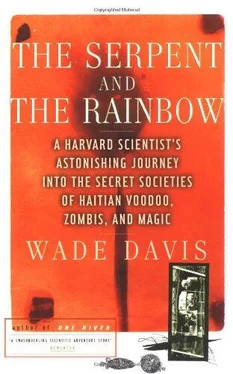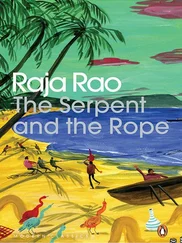Wade Davis - The Serpent and the Rainbow
Здесь есть возможность читать онлайн «Wade Davis - The Serpent and the Rainbow» весь текст электронной книги совершенно бесплатно (целиком полную версию без сокращений). В некоторых случаях можно слушать аудио, скачать через торрент в формате fb2 и присутствует краткое содержание. Год выпуска: 1985, Издательство: Simon & Schuster, Жанр: Старинная литература, на английском языке. Описание произведения, (предисловие) а так же отзывы посетителей доступны на портале библиотеки ЛибКат.
- Название:The Serpent and the Rainbow
- Автор:
- Издательство:Simon & Schuster
- Жанр:
- Год:1985
- ISBN:нет данных
- Рейтинг книги:5 / 5. Голосов: 1
-
Избранное:Добавить в избранное
- Отзывы:
-
Ваша оценка:
- 100
- 1
- 2
- 3
- 4
- 5
The Serpent and the Rainbow: краткое содержание, описание и аннотация
Предлагаем к чтению аннотацию, описание, краткое содержание или предисловие (зависит от того, что написал сам автор книги «The Serpent and the Rainbow»). Если вы не нашли необходимую информацию о книге — напишите в комментариях, мы постараемся отыскать её.
The Serpent and the Rainbow — читать онлайн бесплатно полную книгу (весь текст) целиком
Ниже представлен текст книги, разбитый по страницам. Система сохранения места последней прочитанной страницы, позволяет с удобством читать онлайн бесплатно книгу «The Serpent and the Rainbow», без необходимости каждый раз заново искать на чём Вы остановились. Поставьте закладку, и сможете в любой момент перейти на страницу, на которой закончили чтение.
Интервал:
Закладка:
Two days later the first plantation burned, and then on the night of August 21 the slaves at five plantations around Macandal’s old territory rose up and moved on the center of Limbé. By morning Acul was in flames, Limbé destroyed, and throughout the next day the uprising rode the sound of the conch trumpets as one by one each settlement in the north fell—Plaine du Nord, Dondon, Marmelade, Plaisance. In a single night of indescribable horror, a thousand whites were strangled and two thousand sugar and coffee mills destroyed. For days dark columns of smoke rose beyond a wall of flames that isolated the entire northern half of the colony. Fire rained from clouds of burning straw torn from fields and swept up by the fireballs. Ash coated the sea, and the image of an entire land aflame reddened clouds as far away as the Bahamas.
After the first weeks of the uprising, as the frenzy of destruction gave way to skirmishes and then out-and-out battles with the colonial militia, the ranks of the slaves coalesced around certain leaders, who in turn drew their inspiration from the gods. In the western province Romaine La Prophétesse marched to the music of drums and conch shells, behind an entourage of houngan chanting that the weapons of the whites, their cannon and muskets, were bamboo, their gunpowder but dust; his personal guard carried only long cowtails blessed by the spirits and thus capable of deflecting the bullets of the whites. Sorcerers and magicians composed the staff of Biassou, and much of his own tent was devoted to amulets and sacred objects and devotions. In his camps great fires flared by night as naked women invoked the spirits, singing words known only in “the deserts of Africa.” Biassou walked in triumph, exalting his people, telling them that if they were fortunate enough to fall in battle, they would rise again from the hearth of Africa to seed their ancient tribes. A contemporary report from Cap Francis suggests that the black women of the capital went out at night, singing words unintelligible to the whites. For some time they “had adopted an almost uniform dress, around their bellies wearing kerchiefs in which the color red dominated…. The Voodoo King had just declared war (they said) and accompanied by his Queen dressed in red scarf and agitating the little bells decorating the box containing the snake, they marched to the assault of the colony’s cities.”
If vodoun charged the revolt, the tactics and organization of the rebel bands came directly from the precedent established by the Maroons. With increasing boldness the rebels poured out of the hills ravaging plantations, disrupting communication, and plundering supply trains. Raiding by night, they left in their wake fire, poison, and corpses, before retreating at daybreak into every inaccessible gorge and ravine in the land. There they lived as they had always, protected by palisades and rings of sentinels, and most critically by the potent magic of their sorcerers. A French force of some twenty-four hundred troops dispatched in early February 1792 to invade and destroy rebel camps reported being “astonished to see stuck in the ground along the route large perches on which a variety of dead birds had been affixed…. On the road at intervals there were cut up birds surrounded by stones, and also a dozen broken eggs surrounded by large circles. What was our surprise to see black males leaping about and more than 200 women dancing and singing in all security…. The Voodoo priestess had not fled … she spoke no creole…. Both the men and the women said that there could be no human power over her … she was of the Voodoo cult.” The leader of the French expedition also encountered the cloak of secrecy that continued to protect the rebels as it had the Maroons. From a woman initiate he learned that “there was a password but she would never give it to me…. She gave me the hand recognition sign: it was somewhat similar to that of the Masons. She told me this as a secret, assuring me … I would be killed or poisoned if I tried to penetrate the great mystery of the sect.”
Perhaps unfortunately for the ex-slaves, they were not alone in their quest for freedom. For some time tension had been growing between the white planters and the enfranchised mulattos. The latter, though equal in numbers to the whites, and entitled by law to all the privileges of French citizens, were, in fact, treated as a class apart. Social discrimination of the crudest sort had made them resentful, and at the same time their energetic exercise of their right to property had made them exceedingly wealthy and powerful; this was a dangerous combination for the French, especially once fanned by the rebellious ideas that had grown out of the American and French Revolutions. Even before the uprising of the slaves, a force of mulattos had marched on the government demanding full implementation of the accords worked out by the revolutionary assemblies in Paris. Their incipient revolt failed, and the leaders were brutally tortured, but it was the first incident in a struggle that would, in time, pit whites against mulattos, whites against mulattos allied with blacks, and mulattos against whites working sometimes with and sometimes against the interests of the black ex-slaves. The result was a reign of confusion, chaos, and destruction that after two years left the French in control of the cities, the blacks firmly entrenched in the countryside, and the mulattos still caught in between.
In February 1793 the Haitian revolution was profoundly affected by the war that broke out in Europe between Republican France and England allied to Spain. To the problems of the colonial administration, already preoccupied by political events in Paris, stunned by the uprising of the slaves, and torn asunder by the power struggle between mulatto and white planters, was now added the threat of an enemy army moving overland from the Spanish colony of Santo Domingo. The Maroons predictably aligned themselves with the invaders, and their leaders Biassou and Jean François—Boukman by then being dead—became officers in the Spanish army, as did Toussaint, an ex-slave who had not left bondage until some months after the uprising, but who was about to begin his meteoric rise to power.
The French, hard-pressed even before the Spanish invasion, were now forced to negotiate with the Maroons, and in the summer of 1793, under pressure from the rebel leaders, the colonial administration officially abolished slavery. But the Maroons soon recognized the proclamation for what it was—no more than a desperate attempt to defuse the explosive potential of the blacks, while retaining intact the essential structure of the colonial economic order. Biassou and Jean François rejected the French offer and defiantly remained allied to the Spanish, who had promised unconditional emancipation. But for reasons that would only come clear in the light of subsequent events, Toussaint shifted his allegiance back to the French. Then, at a time when he remained unquestionably less powerful than the prominent Maroon leaders, Toussaint and his forces ambushed the camps of Biassou and Jean François, killing many of their followers and turning those that survived over to the French authorities.
Toussaint moved quickly to consolidate his position, and by 1797, having defeated two foreign armies as well as a rival mulatto force, this ex-slave, by now christened Toussaint L’Ouverture, emerged as the absolute ruler of all Saint Domingue. He then set to work to restore under French rule the order and prosperity of the colony. And of what type of colony, there could be no doubt. The people, though nominally free, were in fact compelled to work in a manner reminiscent of exactly the system they had fought so desperately to overthrow. Toussaint’s autocratic decrees prohibited movement between plantations and ordered those without urban trades to the fields, where they labored under military supervision. True, he eliminated the worst excesses of the colonial brutality, but the essential structure of the plantation system remained just as the French had intended. As for the traditional beliefs of the people, Toussaint as a devout Roman Catholic had no interest in what he considered the pagan beliefs of Africa.
Читать дальшеИнтервал:
Закладка:
Похожие книги на «The Serpent and the Rainbow»
Представляем Вашему вниманию похожие книги на «The Serpent and the Rainbow» списком для выбора. Мы отобрали схожую по названию и смыслу литературу в надежде предоставить читателям больше вариантов отыскать новые, интересные, ещё непрочитанные произведения.
Обсуждение, отзывы о книге «The Serpent and the Rainbow» и просто собственные мнения читателей. Оставьте ваши комментарии, напишите, что Вы думаете о произведении, его смысле или главных героях. Укажите что конкретно понравилось, а что нет, и почему Вы так считаете.












